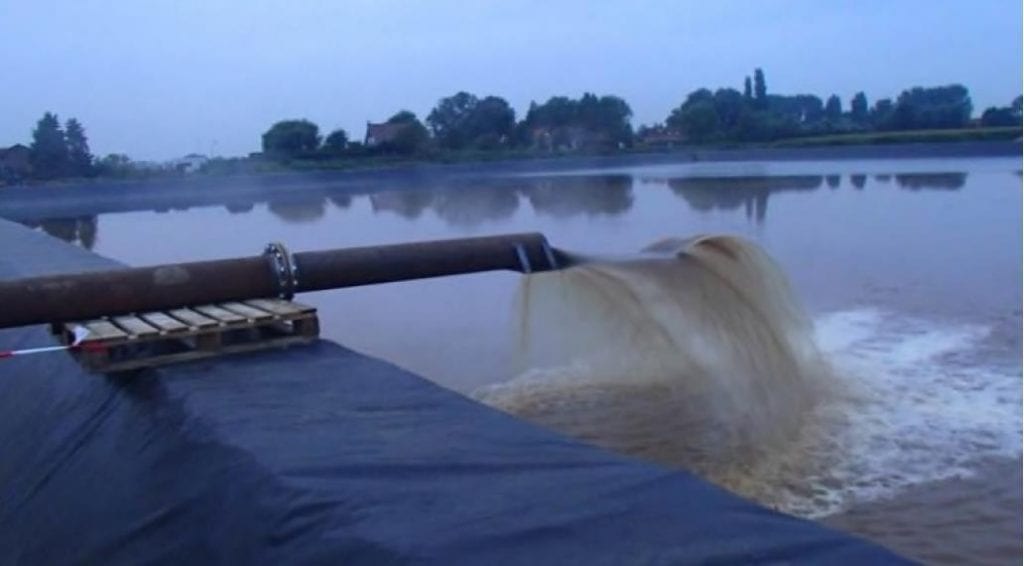Geothermal brine contains several precious minerals that should be utilized.

A pool containing geothermal brine (Hartog, Baken and Koeman-stein, 2019)
Lithium is an element with extensive usage in various sectors of life, such as energy, industrial, pharmaceutical, manufacturing, and economic (Manao et al., 2012). In Indonesia, lithium is commonly found as the raw material of the anode in lithium-ion batteries. The need for lithium is predicted to increase along with the growth of the electric vehicle industries. Unfortunately, Indonesia has a lack of lithium supply that most of the lithium needs fulfilling by import. Based on data from the Badan Pusat Statistik, the import of the lithium batteries in 2016 reached 91 million U.S. dollars, or USD 1.18 trillion (Kementerian Perindustrian, 2017). The lack of lithium supply is caused by less exploration of the sources of lithium in Indonesia. The Ministry of Research and Technology has set a target that Indonesia will produce lithium batteries independently in 2022 (Widyanuratikah, 2019). To achieve this target, some alternative lithium sources should be explored. Which of Indonesia’s natural resources can be exploited as an alternative lithium source?
Geothermal Brine; an Alternative Source of Lithium
Indonesia is located on the path of the pacific ring of fire with 129 active volcanoes. It causes our country to have abundant geothermal resources. Geothermal potential of Indonesia is estimated at 29 GW, or 40% of the total potential in the world (Henuk and Halawa, 2016). The manifestations of geothermal are in the form of fumaroles, the land of steamy hot, sintered silica, alteration hydrothermal, and hot springs which can be found in mountainous regions (Hariyanto and Narendra Robawa, 2016). In Indonesia, geothermal energy is used to generate electricity. The process of electricity generation starts with injecting water into the bowels of the earth. The water will be heated and evaporates partially into steam pressure. Steam and water from production wells are separated using a separator. Then, steam drives the turbine and subsequently run the generator to produce electricity. While the water that is called brine is not utilized, so it’s directly returned to the bowels of the earth (Kusuma et al., 2018). Some researches showed that the geothermal brine contains several precious minerals (Si, Li, K, etc.) that should be utilized. Dieng, one of the geothermal sources in Indonesia, possesses lithium concentration of about 40-60 ppm (Pambudi et al., 2015). Based on those facts, it is proved that geothermal brine can be used as an alternative source of lithium in the future. The next question would be, what kind of technology can be applied to recover lithium from geothermal brine?
Method of Extracting Lithium from Geothermal Brine
Since the potential of the geothermal brine as a source of lithium has been discovered, the researchers strive to create feasible and efficient methods and extraction technology. The scaling, corrosion, and some of the other problems become challenges in the development of this technology. See this challenge, the Unconventional Georesources Research Group at the Faculty of Engineering UGM participate and contribute by doing research related to that topic. There are currently three methods of extraction that have been applicable proven, that is, adsorption, ion exchange, and electrodialysis (SAMCO, 2018). First, adsorption is a method of extraction which has principles of the absorption of the adsorbate (LiCl) to the surface of the adsorbent. This process is carried out using an extraction column that contains the LDH (lithium aluminum layered double hydroxide chloride) adsorbent. LDH adsorbent consists of several layers of [LiAl2(OH)6]+. These layers are separated by water molecules and hydroxide ions that form empty spaces for LiCl. After the surface of the adsorbent is saturated, washing is done to release the LiCl (Paranthaman et al., 2017). Second, ion exchange is the method of extraction with the principles of exchange the positively charged lithium-ion with the other positively charged ion, which mediated by the resin. The used resin is aluminum hydroxide which contains sodium ions. The sodium ions will be exchanged with the lithium-ion through a chemical process physical. Washing is done to release the lithium-ion from the resin (Fukuda, 2019). Third, electrodialysis is a method of extraction principled by the transfer of lithium from geothermal brine to concentrate driven by the electric potential difference. The electrodialysis reactor consisted of a container divided into several compartments, that is the electrolyte, diluate, and concentrate. The ion exchanger membrane is used as a compartments divider. Ion which has the same charge with the membrane can not pass through the membrane so that it cannot move to another compartment. Membranes are arranged in such a way that the lithium-ion concentrated in the concentrate compartment (Mroczek et al., 2015).
The exploration of alternative sources of lithium should be done continuously so that the lithium can be a renewable energy source to meet the energy needs in the future. Evolving technology allows the low cost and environmentally friendly recovery method of lithium from nature can be done.
SOURCE:
- Fukuda, H. (2019) ‘Lithium Extraction From Brine’, (July). doi: 10.14288/1.0379929.
- Hariyanto, T. and Narendra Robawa, F. (2016) ‘Pembangkit Listrik Tenaga Panas Bumi (Studi Kasus : Kawasan Gunung Lawu)’.
- Hartog, N., Baken, A. and Koeman-stein, N. (2019) ‘Eutectic Freeze Crystallization ( Efc ): a Cool Solution for Processing Geothermal Waste Brines ?’, (June), pp. 11–14.
- Henuk, Y. L. and Halawa, A. (2016) ‘Geothermal Potential and Development in Indonesia’, Seminar Nasional ke-3, Fakultas Teknik Geologi, Universitas Padjadjaran, pp. 1–13. Available at: http://ftgeologi.unpad.ac.id/wp-content/uploads/2018/04/Geothermal-Potential-and-Development-in-Indonesia.pdf.
- Kementerian Perindustrian (2017) Baterai Lokal Berpotensi Tekan Impor. Available at: https://kemenperin.go.id/artikel/17917/Baterai-Lokal-Berpotensi-Tekan-Impor (Accessed: 17 June 2020).
- Kusuma, G. A. et al. (2018) ‘Analisa Efisiensi Thermal Pembangkit Listrik Tenaga Panas Bumi Lahendong Unit 5 Dan 6 Di Tompaso’, Jurnal Teknik Elektro dan Komputer, 7(2), pp. 123–134. doi: 10.35793/jtek.7.2.2018.19614.
- Manao, R. D. et al. (2012) ‘Recovery Garam Lithium Pada Air Tua ( Bittern ) Dengan Metode Presipitasi’, 1(1), pp. 292–297.
- Mroczek, E. et al. (2015) ‘Lithium Extraction from Wairakei Geothermal Fluid using Electrodialysis’, Proceedings of the World Geothermal Congress 2015, (April), p. 6.
- Paranthaman, M. P. et al. (2017) ‘Recovery of Lithium from Geothermal Brine with Lithium-Aluminum Layered Double Hydroxide Chloride Sorbents’, Environmental Science and Technology, 51(22), pp. 13481–13486. doi: 10.1021/acs.est.7b03464.
- SAMCO (2018) What is The Best Way for Recovering Lithium from Geothermal Brine? Available at: https://www.samcotech.com/best-way-recovering-lithium-from-geothermal-brine/ (Accessed: 19 June 2020).
- Widyanuratikah, I. (2019) ‘2022, Indonesia Targetkan Mampu Buat Baterai Lithium’. Available at: https://republika.co.id/berita/pendidikan/dunia-kampus/pseoh7368/2022-indonesia-targetkan-mampu-buat-baterai-lithium.

Priskila Natalia
Priskila Natalia is an enthusiastic person who enjoys a challenge and achieving personal goals. She has a responsible approach to any task that she undertakes. She has a passion for creating innovative new ideas to solve problems.

Follow Us!